Reflective Essay: Analyzing Effective Business Communication Skills
VerifiedAdded on 2020/03/16
|13
|3629
|383
Essay
AI Summary
This reflective essay delves into the author's self-assessment of their communication skills, utilizing various diagnostic tools to identify strengths and weaknesses. The essay explores areas such as public speaking anxiety, intercultural communication, and nonverbal communication. The author acknowledges discomfort in public speaking situations and over-reliance on nonverbal cues, providing personal anecdotes and supporting literature to illustrate these points. The essay examines the impact of communication apprehension and the importance of effective communication in both academic and professional settings. It highlights the significance of controlling nonverbal cues and building confidence in public speaking through literature review and personal experience. The essay discusses strategies for improving communication skills, drawing on research that emphasizes the need for effective communication in business and professional contexts. The author provides an analysis of their communication style and preferences and identifies key issues, backed by the use of diagnostic tools and the use of personal experiences. The essay concludes by emphasizing the need to develop public speaking skills and manage nonverbal cues to enhance overall communication effectiveness.

Paraphrase This Document
Need a fresh take? Get an instant paraphrase of this document with our AI Paraphraser
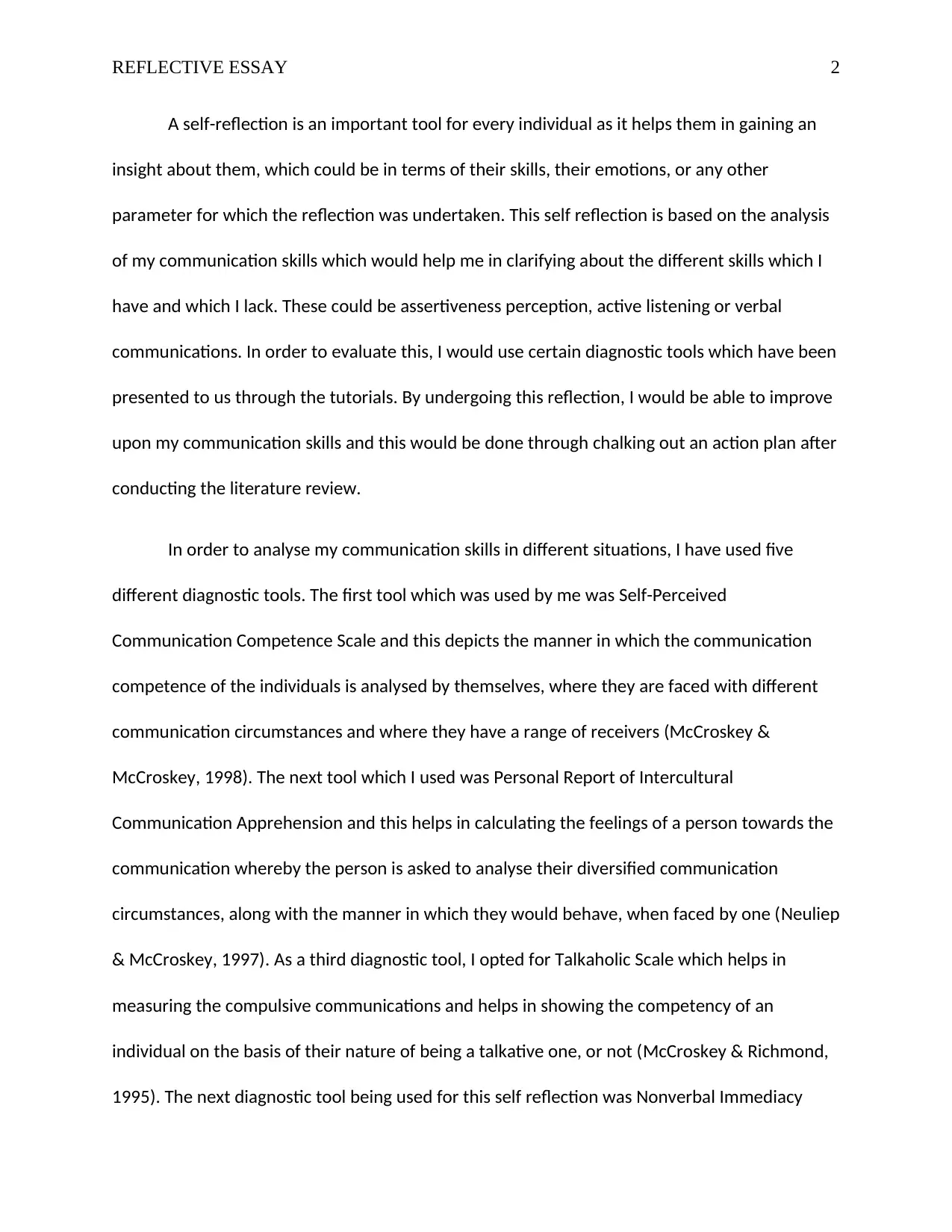
REFLECTIVE ESSAY 2
A self-reflection is an important tool for every individual as it helps them in gaining an
insight about them, which could be in terms of their skills, their emotions, or any other
parameter for which the reflection was undertaken. This self reflection is based on the analysis
of my communication skills which would help me in clarifying about the different skills which I
have and which I lack. These could be assertiveness perception, active listening or verbal
communications. In order to evaluate this, I would use certain diagnostic tools which have been
presented to us through the tutorials. By undergoing this reflection, I would be able to improve
upon my communication skills and this would be done through chalking out an action plan after
conducting the literature review.
In order to analyse my communication skills in different situations, I have used five
different diagnostic tools. The first tool which was used by me was Self-Perceived
Communication Competence Scale and this depicts the manner in which the communication
competence of the individuals is analysed by themselves, where they are faced with different
communication circumstances and where they have a range of receivers (McCroskey &
McCroskey, 1998). The next tool which I used was Personal Report of Intercultural
Communication Apprehension and this helps in calculating the feelings of a person towards the
communication whereby the person is asked to analyse their diversified communication
circumstances, along with the manner in which they would behave, when faced by one (Neuliep
& McCroskey, 1997). As a third diagnostic tool, I opted for Talkaholic Scale which helps in
measuring the compulsive communications and helps in showing the competency of an
individual on the basis of their nature of being a talkative one, or not (McCroskey & Richmond,
1995). The next diagnostic tool being used for this self reflection was Nonverbal Immediacy
A self-reflection is an important tool for every individual as it helps them in gaining an
insight about them, which could be in terms of their skills, their emotions, or any other
parameter for which the reflection was undertaken. This self reflection is based on the analysis
of my communication skills which would help me in clarifying about the different skills which I
have and which I lack. These could be assertiveness perception, active listening or verbal
communications. In order to evaluate this, I would use certain diagnostic tools which have been
presented to us through the tutorials. By undergoing this reflection, I would be able to improve
upon my communication skills and this would be done through chalking out an action plan after
conducting the literature review.
In order to analyse my communication skills in different situations, I have used five
different diagnostic tools. The first tool which was used by me was Self-Perceived
Communication Competence Scale and this depicts the manner in which the communication
competence of the individuals is analysed by themselves, where they are faced with different
communication circumstances and where they have a range of receivers (McCroskey &
McCroskey, 1998). The next tool which I used was Personal Report of Intercultural
Communication Apprehension and this helps in calculating the feelings of a person towards the
communication whereby the person is asked to analyse their diversified communication
circumstances, along with the manner in which they would behave, when faced by one (Neuliep
& McCroskey, 1997). As a third diagnostic tool, I opted for Talkaholic Scale which helps in
measuring the compulsive communications and helps in showing the competency of an
individual on the basis of their nature of being a talkative one, or not (McCroskey & Richmond,
1995). The next diagnostic tool being used for this self reflection was Nonverbal Immediacy
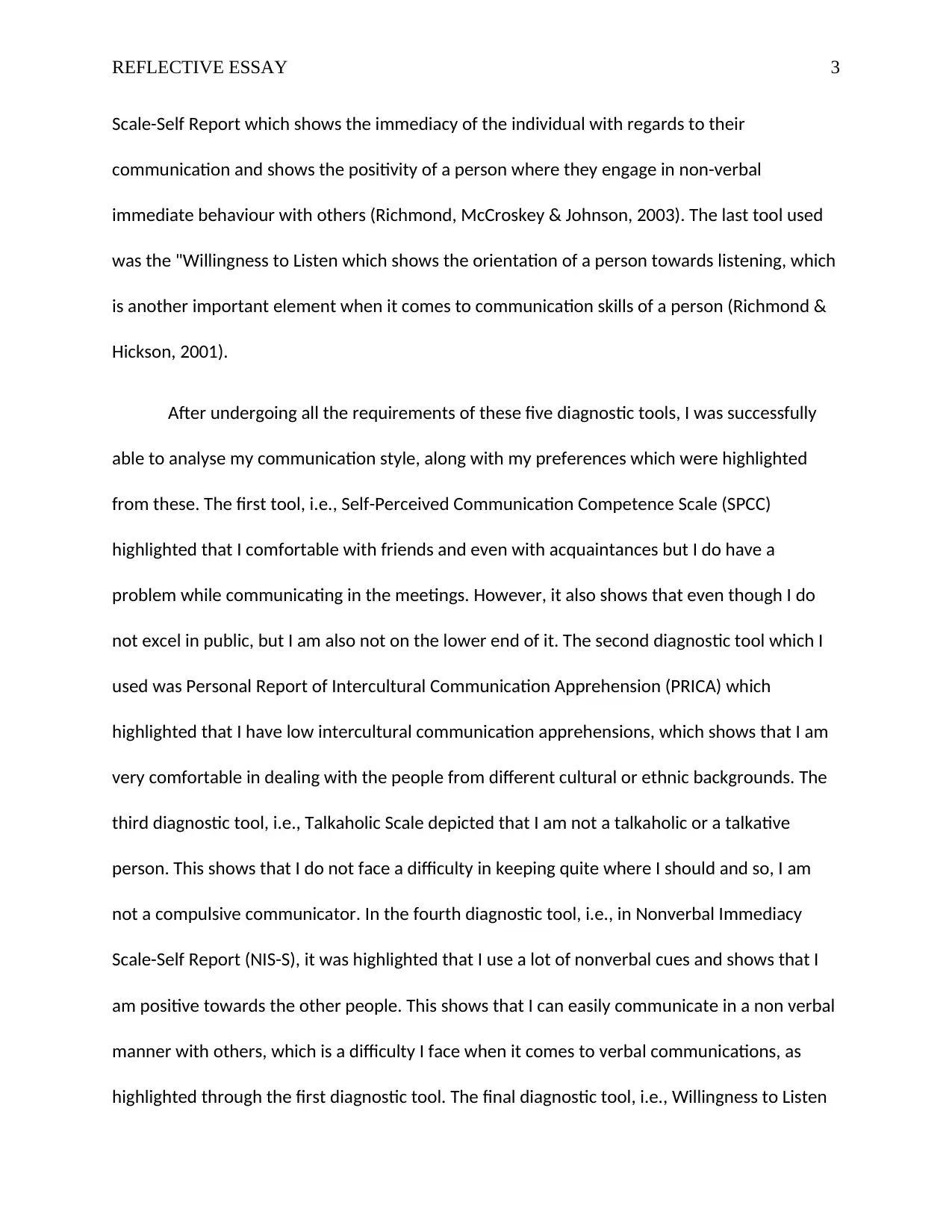
REFLECTIVE ESSAY 3
Scale-Self Report which shows the immediacy of the individual with regards to their
communication and shows the positivity of a person where they engage in non-verbal
immediate behaviour with others (Richmond, McCroskey & Johnson, 2003). The last tool used
was the "Willingness to Listen which shows the orientation of a person towards listening, which
is another important element when it comes to communication skills of a person (Richmond &
Hickson, 2001).
After undergoing all the requirements of these five diagnostic tools, I was successfully
able to analyse my communication style, along with my preferences which were highlighted
from these. The first tool, i.e., Self-Perceived Communication Competence Scale (SPCC)
highlighted that I comfortable with friends and even with acquaintances but I do have a
problem while communicating in the meetings. However, it also shows that even though I do
not excel in public, but I am also not on the lower end of it. The second diagnostic tool which I
used was Personal Report of Intercultural Communication Apprehension (PRICA) which
highlighted that I have low intercultural communication apprehensions, which shows that I am
very comfortable in dealing with the people from different cultural or ethnic backgrounds. The
third diagnostic tool, i.e., Talkaholic Scale depicted that I am not a talkaholic or a talkative
person. This shows that I do not face a difficulty in keeping quite where I should and so, I am
not a compulsive communicator. In the fourth diagnostic tool, i.e., in Nonverbal Immediacy
Scale-Self Report (NIS-S), it was highlighted that I use a lot of nonverbal cues and shows that I
am positive towards the other people. This shows that I can easily communicate in a non verbal
manner with others, which is a difficulty I face when it comes to verbal communications, as
highlighted through the first diagnostic tool. The final diagnostic tool, i.e., Willingness to Listen
Scale-Self Report which shows the immediacy of the individual with regards to their
communication and shows the positivity of a person where they engage in non-verbal
immediate behaviour with others (Richmond, McCroskey & Johnson, 2003). The last tool used
was the "Willingness to Listen which shows the orientation of a person towards listening, which
is another important element when it comes to communication skills of a person (Richmond &
Hickson, 2001).
After undergoing all the requirements of these five diagnostic tools, I was successfully
able to analyse my communication style, along with my preferences which were highlighted
from these. The first tool, i.e., Self-Perceived Communication Competence Scale (SPCC)
highlighted that I comfortable with friends and even with acquaintances but I do have a
problem while communicating in the meetings. However, it also shows that even though I do
not excel in public, but I am also not on the lower end of it. The second diagnostic tool which I
used was Personal Report of Intercultural Communication Apprehension (PRICA) which
highlighted that I have low intercultural communication apprehensions, which shows that I am
very comfortable in dealing with the people from different cultural or ethnic backgrounds. The
third diagnostic tool, i.e., Talkaholic Scale depicted that I am not a talkaholic or a talkative
person. This shows that I do not face a difficulty in keeping quite where I should and so, I am
not a compulsive communicator. In the fourth diagnostic tool, i.e., in Nonverbal Immediacy
Scale-Self Report (NIS-S), it was highlighted that I use a lot of nonverbal cues and shows that I
am positive towards the other people. This shows that I can easily communicate in a non verbal
manner with others, which is a difficulty I face when it comes to verbal communications, as
highlighted through the first diagnostic tool. The final diagnostic tool, i.e., Willingness to Listen
⊘ This is a preview!⊘
Do you want full access?
Subscribe today to unlock all pages.

Trusted by 1+ million students worldwide
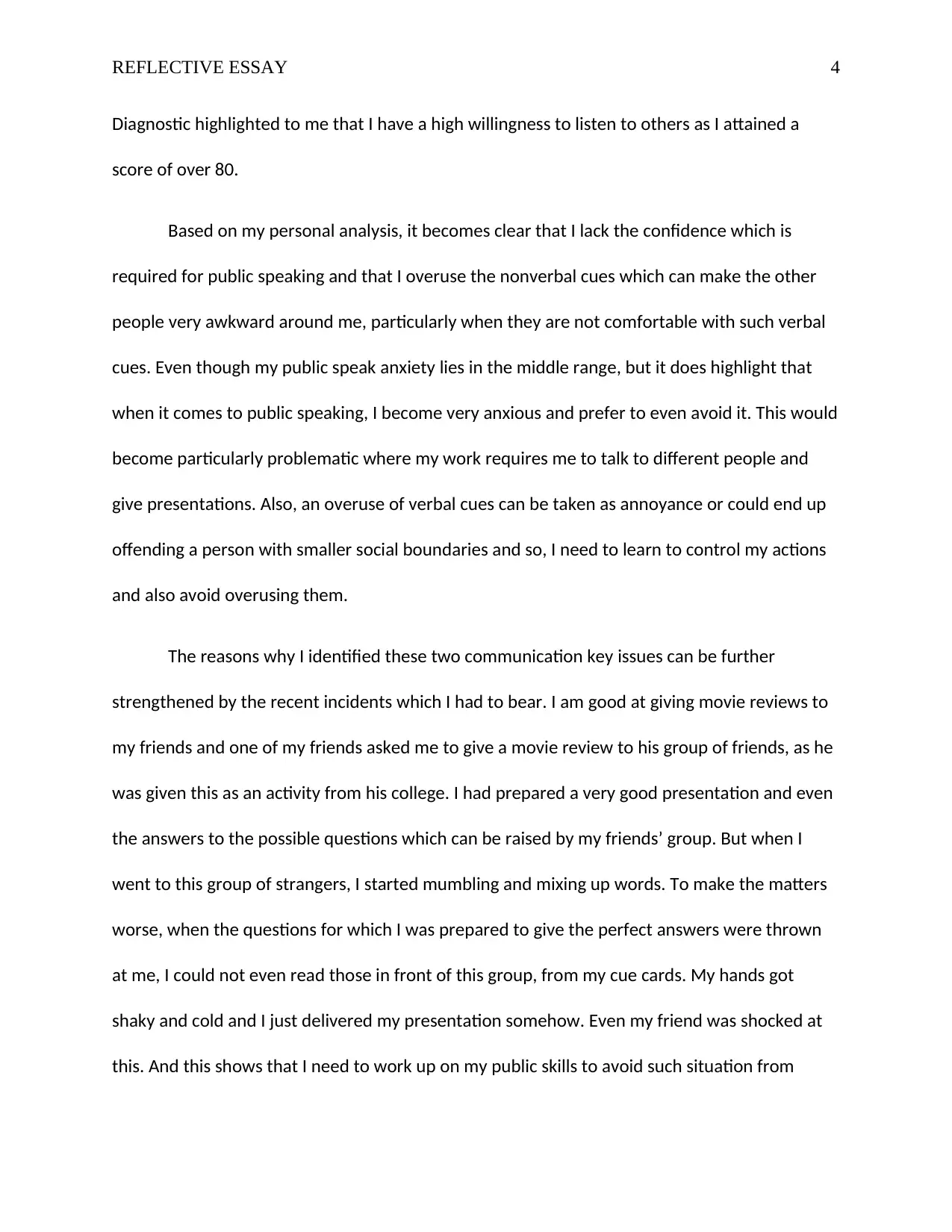
REFLECTIVE ESSAY 4
Diagnostic highlighted to me that I have a high willingness to listen to others as I attained a
score of over 80.
Based on my personal analysis, it becomes clear that I lack the confidence which is
required for public speaking and that I overuse the nonverbal cues which can make the other
people very awkward around me, particularly when they are not comfortable with such verbal
cues. Even though my public speak anxiety lies in the middle range, but it does highlight that
when it comes to public speaking, I become very anxious and prefer to even avoid it. This would
become particularly problematic where my work requires me to talk to different people and
give presentations. Also, an overuse of verbal cues can be taken as annoyance or could end up
offending a person with smaller social boundaries and so, I need to learn to control my actions
and also avoid overusing them.
The reasons why I identified these two communication key issues can be further
strengthened by the recent incidents which I had to bear. I am good at giving movie reviews to
my friends and one of my friends asked me to give a movie review to his group of friends, as he
was given this as an activity from his college. I had prepared a very good presentation and even
the answers to the possible questions which can be raised by my friends’ group. But when I
went to this group of strangers, I started mumbling and mixing up words. To make the matters
worse, when the questions for which I was prepared to give the perfect answers were thrown
at me, I could not even read those in front of this group, from my cue cards. My hands got
shaky and cold and I just delivered my presentation somehow. Even my friend was shocked at
this. And this shows that I need to work up on my public skills to avoid such situation from
Diagnostic highlighted to me that I have a high willingness to listen to others as I attained a
score of over 80.
Based on my personal analysis, it becomes clear that I lack the confidence which is
required for public speaking and that I overuse the nonverbal cues which can make the other
people very awkward around me, particularly when they are not comfortable with such verbal
cues. Even though my public speak anxiety lies in the middle range, but it does highlight that
when it comes to public speaking, I become very anxious and prefer to even avoid it. This would
become particularly problematic where my work requires me to talk to different people and
give presentations. Also, an overuse of verbal cues can be taken as annoyance or could end up
offending a person with smaller social boundaries and so, I need to learn to control my actions
and also avoid overusing them.
The reasons why I identified these two communication key issues can be further
strengthened by the recent incidents which I had to bear. I am good at giving movie reviews to
my friends and one of my friends asked me to give a movie review to his group of friends, as he
was given this as an activity from his college. I had prepared a very good presentation and even
the answers to the possible questions which can be raised by my friends’ group. But when I
went to this group of strangers, I started mumbling and mixing up words. To make the matters
worse, when the questions for which I was prepared to give the perfect answers were thrown
at me, I could not even read those in front of this group, from my cue cards. My hands got
shaky and cold and I just delivered my presentation somehow. Even my friend was shocked at
this. And this shows that I need to work up on my public skills to avoid such situation from
Paraphrase This Document
Need a fresh take? Get an instant paraphrase of this document with our AI Paraphraser
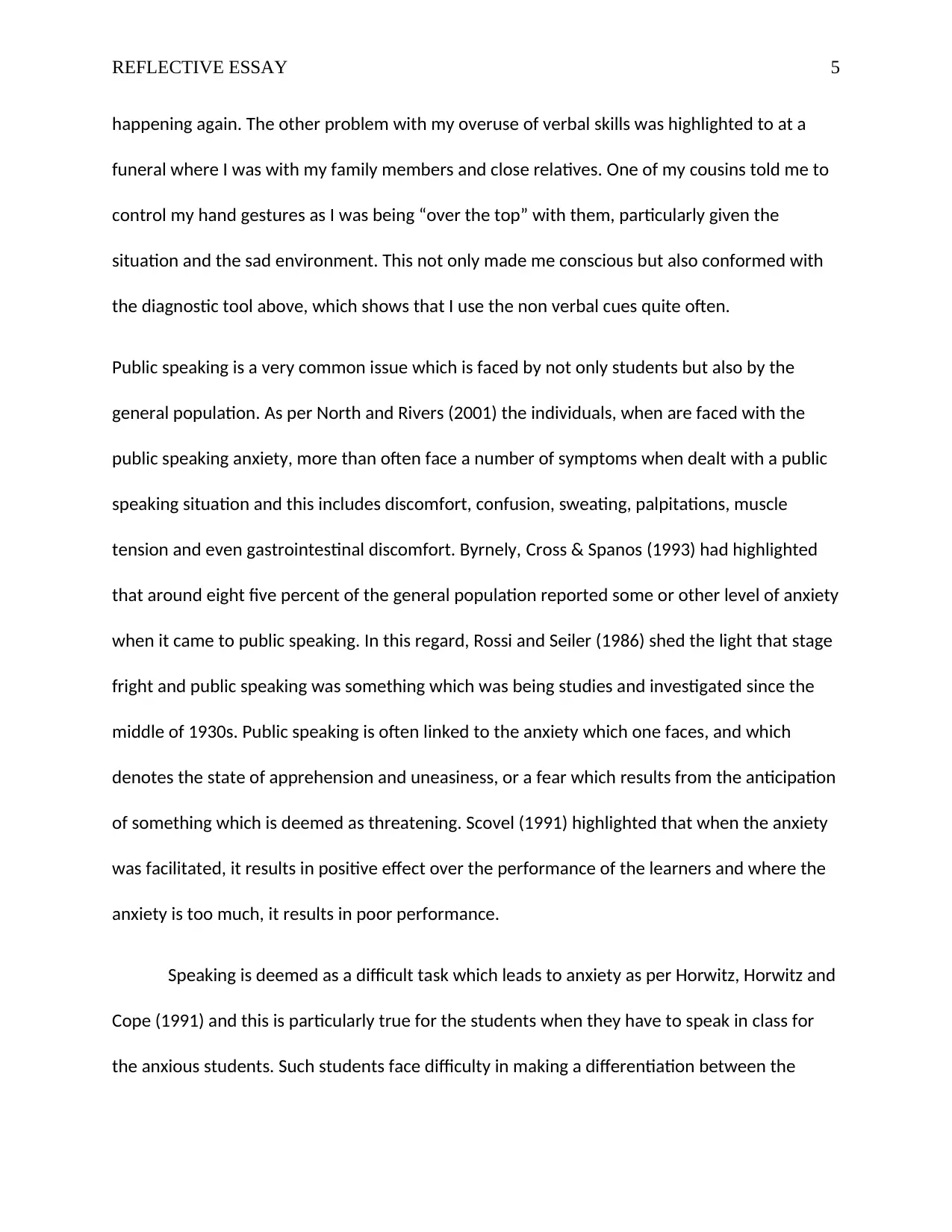
REFLECTIVE ESSAY 5
happening again. The other problem with my overuse of verbal skills was highlighted to at a
funeral where I was with my family members and close relatives. One of my cousins told me to
control my hand gestures as I was being “over the top” with them, particularly given the
situation and the sad environment. This not only made me conscious but also conformed with
the diagnostic tool above, which shows that I use the non verbal cues quite often.
Public speaking is a very common issue which is faced by not only students but also by the
general population. As per North and Rivers (2001) the individuals, when are faced with the
public speaking anxiety, more than often face a number of symptoms when dealt with a public
speaking situation and this includes discomfort, confusion, sweating, palpitations, muscle
tension and even gastrointestinal discomfort. Byrnely, Cross & Spanos (1993) had highlighted
that around eight five percent of the general population reported some or other level of anxiety
when it came to public speaking. In this regard, Rossi and Seiler (1986) shed the light that stage
fright and public speaking was something which was being studies and investigated since the
middle of 1930s. Public speaking is often linked to the anxiety which one faces, and which
denotes the state of apprehension and uneasiness, or a fear which results from the anticipation
of something which is deemed as threatening. Scovel (1991) highlighted that when the anxiety
was facilitated, it results in positive effect over the performance of the learners and where the
anxiety is too much, it results in poor performance.
Speaking is deemed as a difficult task which leads to anxiety as per Horwitz, Horwitz and
Cope (1991) and this is particularly true for the students when they have to speak in class for
the anxious students. Such students face difficulty in making a differentiation between the
happening again. The other problem with my overuse of verbal skills was highlighted to at a
funeral where I was with my family members and close relatives. One of my cousins told me to
control my hand gestures as I was being “over the top” with them, particularly given the
situation and the sad environment. This not only made me conscious but also conformed with
the diagnostic tool above, which shows that I use the non verbal cues quite often.
Public speaking is a very common issue which is faced by not only students but also by the
general population. As per North and Rivers (2001) the individuals, when are faced with the
public speaking anxiety, more than often face a number of symptoms when dealt with a public
speaking situation and this includes discomfort, confusion, sweating, palpitations, muscle
tension and even gastrointestinal discomfort. Byrnely, Cross & Spanos (1993) had highlighted
that around eight five percent of the general population reported some or other level of anxiety
when it came to public speaking. In this regard, Rossi and Seiler (1986) shed the light that stage
fright and public speaking was something which was being studies and investigated since the
middle of 1930s. Public speaking is often linked to the anxiety which one faces, and which
denotes the state of apprehension and uneasiness, or a fear which results from the anticipation
of something which is deemed as threatening. Scovel (1991) highlighted that when the anxiety
was facilitated, it results in positive effect over the performance of the learners and where the
anxiety is too much, it results in poor performance.
Speaking is deemed as a difficult task which leads to anxiety as per Horwitz, Horwitz and
Cope (1991) and this is particularly true for the students when they have to speak in class for
the anxious students. Such students face difficulty in making a differentiation between the
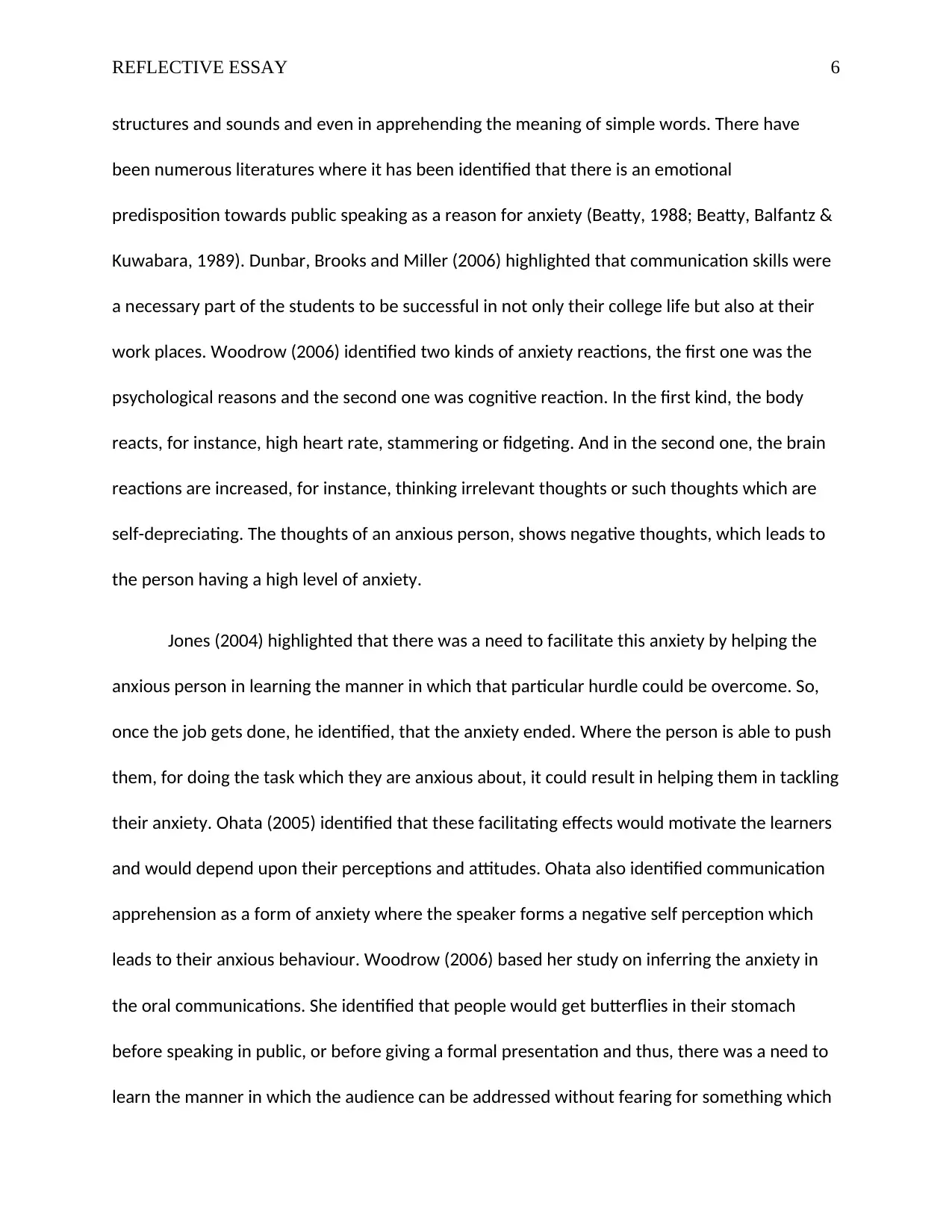
REFLECTIVE ESSAY 6
structures and sounds and even in apprehending the meaning of simple words. There have
been numerous literatures where it has been identified that there is an emotional
predisposition towards public speaking as a reason for anxiety (Beatty, 1988; Beatty, Balfantz &
Kuwabara, 1989). Dunbar, Brooks and Miller (2006) highlighted that communication skills were
a necessary part of the students to be successful in not only their college life but also at their
work places. Woodrow (2006) identified two kinds of anxiety reactions, the first one was the
psychological reasons and the second one was cognitive reaction. In the first kind, the body
reacts, for instance, high heart rate, stammering or fidgeting. And in the second one, the brain
reactions are increased, for instance, thinking irrelevant thoughts or such thoughts which are
self-depreciating. The thoughts of an anxious person, shows negative thoughts, which leads to
the person having a high level of anxiety.
Jones (2004) highlighted that there was a need to facilitate this anxiety by helping the
anxious person in learning the manner in which that particular hurdle could be overcome. So,
once the job gets done, he identified, that the anxiety ended. Where the person is able to push
them, for doing the task which they are anxious about, it could result in helping them in tackling
their anxiety. Ohata (2005) identified that these facilitating effects would motivate the learners
and would depend upon their perceptions and attitudes. Ohata also identified communication
apprehension as a form of anxiety where the speaker forms a negative self perception which
leads to their anxious behaviour. Woodrow (2006) based her study on inferring the anxiety in
the oral communications. She identified that people would get butterflies in their stomach
before speaking in public, or before giving a formal presentation and thus, there was a need to
learn the manner in which the audience can be addressed without fearing for something which
structures and sounds and even in apprehending the meaning of simple words. There have
been numerous literatures where it has been identified that there is an emotional
predisposition towards public speaking as a reason for anxiety (Beatty, 1988; Beatty, Balfantz &
Kuwabara, 1989). Dunbar, Brooks and Miller (2006) highlighted that communication skills were
a necessary part of the students to be successful in not only their college life but also at their
work places. Woodrow (2006) identified two kinds of anxiety reactions, the first one was the
psychological reasons and the second one was cognitive reaction. In the first kind, the body
reacts, for instance, high heart rate, stammering or fidgeting. And in the second one, the brain
reactions are increased, for instance, thinking irrelevant thoughts or such thoughts which are
self-depreciating. The thoughts of an anxious person, shows negative thoughts, which leads to
the person having a high level of anxiety.
Jones (2004) highlighted that there was a need to facilitate this anxiety by helping the
anxious person in learning the manner in which that particular hurdle could be overcome. So,
once the job gets done, he identified, that the anxiety ended. Where the person is able to push
them, for doing the task which they are anxious about, it could result in helping them in tackling
their anxiety. Ohata (2005) identified that these facilitating effects would motivate the learners
and would depend upon their perceptions and attitudes. Ohata also identified communication
apprehension as a form of anxiety where the speaker forms a negative self perception which
leads to their anxious behaviour. Woodrow (2006) based her study on inferring the anxiety in
the oral communications. She identified that people would get butterflies in their stomach
before speaking in public, or before giving a formal presentation and thus, there was a need to
learn the manner in which the audience can be addressed without fearing for something which
⊘ This is a preview!⊘
Do you want full access?
Subscribe today to unlock all pages.

Trusted by 1+ million students worldwide
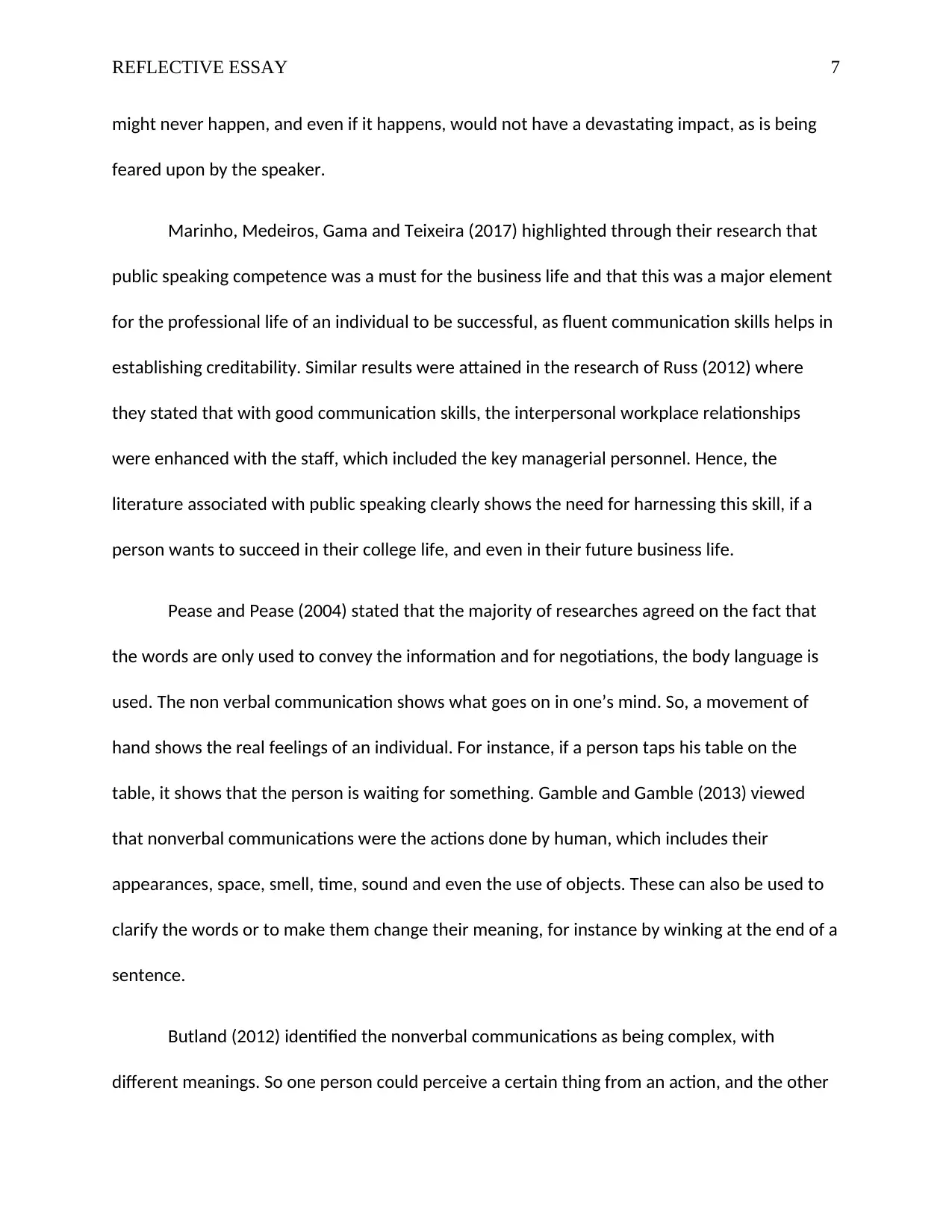
REFLECTIVE ESSAY 7
might never happen, and even if it happens, would not have a devastating impact, as is being
feared upon by the speaker.
Marinho, Medeiros, Gama and Teixeira (2017) highlighted through their research that
public speaking competence was a must for the business life and that this was a major element
for the professional life of an individual to be successful, as fluent communication skills helps in
establishing creditability. Similar results were attained in the research of Russ (2012) where
they stated that with good communication skills, the interpersonal workplace relationships
were enhanced with the staff, which included the key managerial personnel. Hence, the
literature associated with public speaking clearly shows the need for harnessing this skill, if a
person wants to succeed in their college life, and even in their future business life.
Pease and Pease (2004) stated that the majority of researches agreed on the fact that
the words are only used to convey the information and for negotiations, the body language is
used. The non verbal communication shows what goes on in one’s mind. So, a movement of
hand shows the real feelings of an individual. For instance, if a person taps his table on the
table, it shows that the person is waiting for something. Gamble and Gamble (2013) viewed
that nonverbal communications were the actions done by human, which includes their
appearances, space, smell, time, sound and even the use of objects. These can also be used to
clarify the words or to make them change their meaning, for instance by winking at the end of a
sentence.
Butland (2012) identified the nonverbal communications as being complex, with
different meanings. So one person could perceive a certain thing from an action, and the other
might never happen, and even if it happens, would not have a devastating impact, as is being
feared upon by the speaker.
Marinho, Medeiros, Gama and Teixeira (2017) highlighted through their research that
public speaking competence was a must for the business life and that this was a major element
for the professional life of an individual to be successful, as fluent communication skills helps in
establishing creditability. Similar results were attained in the research of Russ (2012) where
they stated that with good communication skills, the interpersonal workplace relationships
were enhanced with the staff, which included the key managerial personnel. Hence, the
literature associated with public speaking clearly shows the need for harnessing this skill, if a
person wants to succeed in their college life, and even in their future business life.
Pease and Pease (2004) stated that the majority of researches agreed on the fact that
the words are only used to convey the information and for negotiations, the body language is
used. The non verbal communication shows what goes on in one’s mind. So, a movement of
hand shows the real feelings of an individual. For instance, if a person taps his table on the
table, it shows that the person is waiting for something. Gamble and Gamble (2013) viewed
that nonverbal communications were the actions done by human, which includes their
appearances, space, smell, time, sound and even the use of objects. These can also be used to
clarify the words or to make them change their meaning, for instance by winking at the end of a
sentence.
Butland (2012) identified the nonverbal communications as being complex, with
different meanings. So one person could perceive a certain thing from an action, and the other
Paraphrase This Document
Need a fresh take? Get an instant paraphrase of this document with our AI Paraphraser
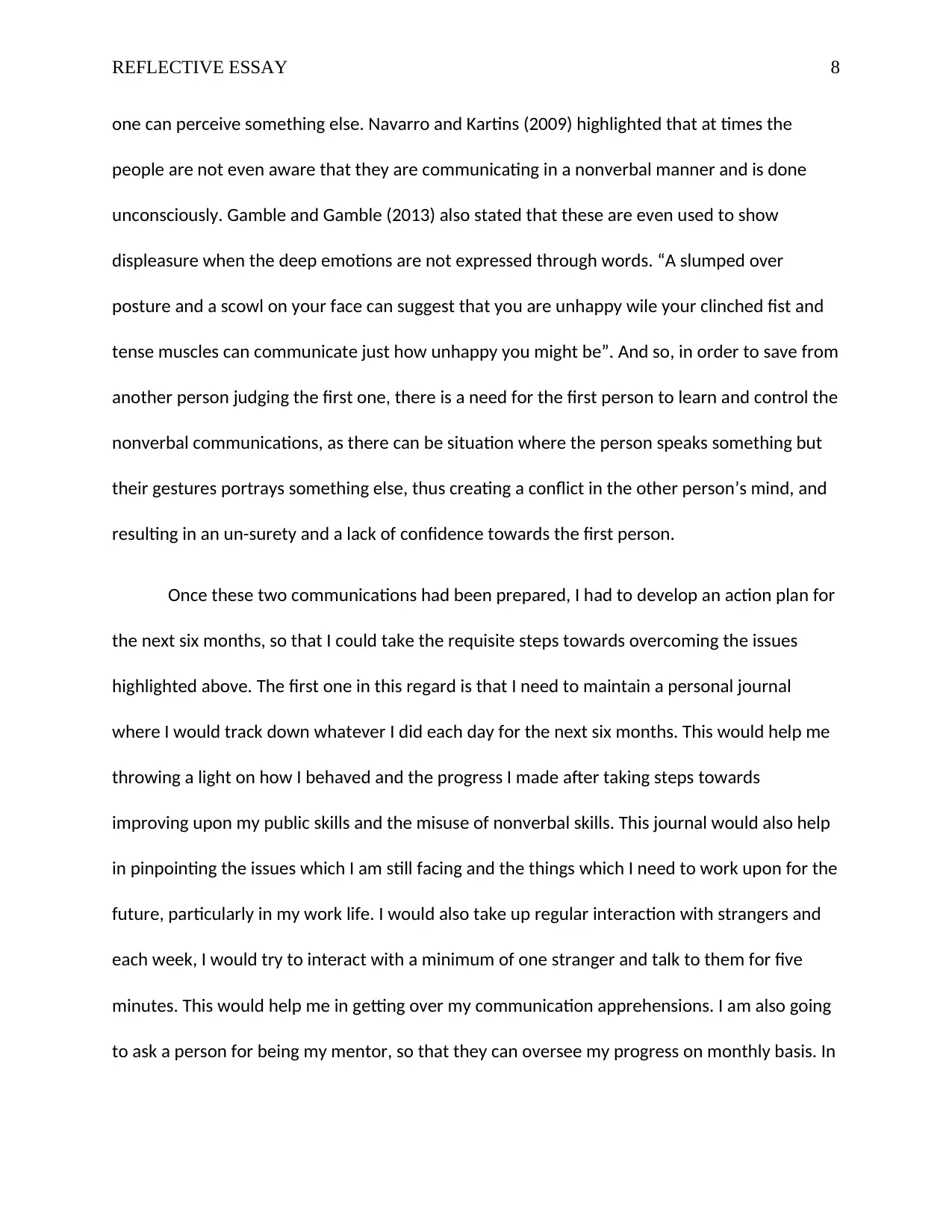
REFLECTIVE ESSAY 8
one can perceive something else. Navarro and Kartins (2009) highlighted that at times the
people are not even aware that they are communicating in a nonverbal manner and is done
unconsciously. Gamble and Gamble (2013) also stated that these are even used to show
displeasure when the deep emotions are not expressed through words. “A slumped over
posture and a scowl on your face can suggest that you are unhappy wile your clinched fist and
tense muscles can communicate just how unhappy you might be”. And so, in order to save from
another person judging the first one, there is a need for the first person to learn and control the
nonverbal communications, as there can be situation where the person speaks something but
their gestures portrays something else, thus creating a conflict in the other person’s mind, and
resulting in an un-surety and a lack of confidence towards the first person.
Once these two communications had been prepared, I had to develop an action plan for
the next six months, so that I could take the requisite steps towards overcoming the issues
highlighted above. The first one in this regard is that I need to maintain a personal journal
where I would track down whatever I did each day for the next six months. This would help me
throwing a light on how I behaved and the progress I made after taking steps towards
improving upon my public skills and the misuse of nonverbal skills. This journal would also help
in pinpointing the issues which I am still facing and the things which I need to work upon for the
future, particularly in my work life. I would also take up regular interaction with strangers and
each week, I would try to interact with a minimum of one stranger and talk to them for five
minutes. This would help me in getting over my communication apprehensions. I am also going
to ask a person for being my mentor, so that they can oversee my progress on monthly basis. In
one can perceive something else. Navarro and Kartins (2009) highlighted that at times the
people are not even aware that they are communicating in a nonverbal manner and is done
unconsciously. Gamble and Gamble (2013) also stated that these are even used to show
displeasure when the deep emotions are not expressed through words. “A slumped over
posture and a scowl on your face can suggest that you are unhappy wile your clinched fist and
tense muscles can communicate just how unhappy you might be”. And so, in order to save from
another person judging the first one, there is a need for the first person to learn and control the
nonverbal communications, as there can be situation where the person speaks something but
their gestures portrays something else, thus creating a conflict in the other person’s mind, and
resulting in an un-surety and a lack of confidence towards the first person.
Once these two communications had been prepared, I had to develop an action plan for
the next six months, so that I could take the requisite steps towards overcoming the issues
highlighted above. The first one in this regard is that I need to maintain a personal journal
where I would track down whatever I did each day for the next six months. This would help me
throwing a light on how I behaved and the progress I made after taking steps towards
improving upon my public skills and the misuse of nonverbal skills. This journal would also help
in pinpointing the issues which I am still facing and the things which I need to work upon for the
future, particularly in my work life. I would also take up regular interaction with strangers and
each week, I would try to interact with a minimum of one stranger and talk to them for five
minutes. This would help me in getting over my communication apprehensions. I am also going
to ask a person for being my mentor, so that they can oversee my progress on monthly basis. In
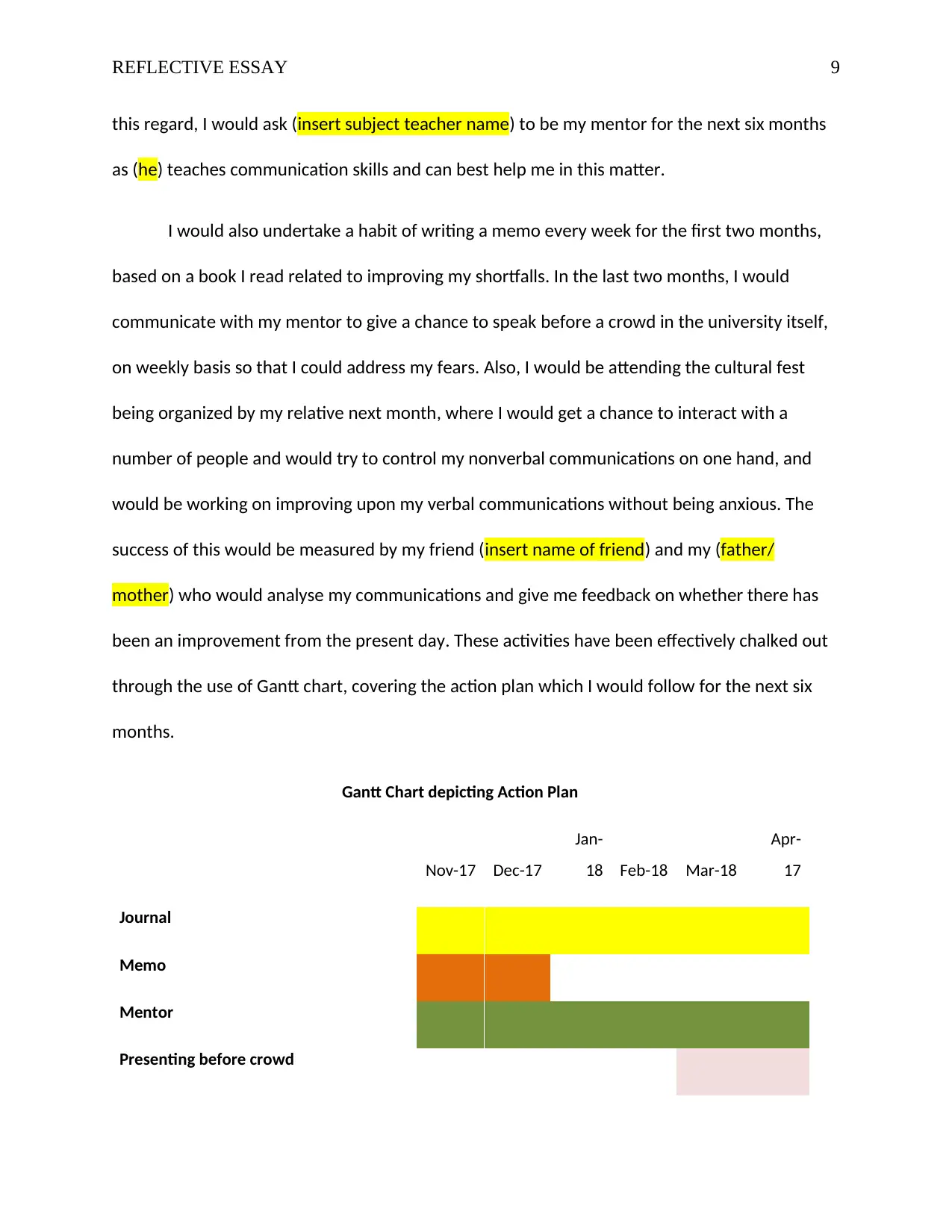
REFLECTIVE ESSAY 9
this regard, I would ask (insert subject teacher name) to be my mentor for the next six months
as (he) teaches communication skills and can best help me in this matter.
I would also undertake a habit of writing a memo every week for the first two months,
based on a book I read related to improving my shortfalls. In the last two months, I would
communicate with my mentor to give a chance to speak before a crowd in the university itself,
on weekly basis so that I could address my fears. Also, I would be attending the cultural fest
being organized by my relative next month, where I would get a chance to interact with a
number of people and would try to control my nonverbal communications on one hand, and
would be working on improving upon my verbal communications without being anxious. The
success of this would be measured by my friend (insert name of friend) and my (father/
mother) who would analyse my communications and give me feedback on whether there has
been an improvement from the present day. These activities have been effectively chalked out
through the use of Gantt chart, covering the action plan which I would follow for the next six
months.
Gantt Chart depicting Action Plan
Nov-17 Dec-17
Jan-
18 Feb-18 Mar-18
Apr-
17
Journal
Memo
Mentor
Presenting before crowd
this regard, I would ask (insert subject teacher name) to be my mentor for the next six months
as (he) teaches communication skills and can best help me in this matter.
I would also undertake a habit of writing a memo every week for the first two months,
based on a book I read related to improving my shortfalls. In the last two months, I would
communicate with my mentor to give a chance to speak before a crowd in the university itself,
on weekly basis so that I could address my fears. Also, I would be attending the cultural fest
being organized by my relative next month, where I would get a chance to interact with a
number of people and would try to control my nonverbal communications on one hand, and
would be working on improving upon my verbal communications without being anxious. The
success of this would be measured by my friend (insert name of friend) and my (father/
mother) who would analyse my communications and give me feedback on whether there has
been an improvement from the present day. These activities have been effectively chalked out
through the use of Gantt chart, covering the action plan which I would follow for the next six
months.
Gantt Chart depicting Action Plan
Nov-17 Dec-17
Jan-
18 Feb-18 Mar-18
Apr-
17
Journal
Memo
Mentor
Presenting before crowd
⊘ This is a preview!⊘
Do you want full access?
Subscribe today to unlock all pages.

Trusted by 1+ million students worldwide
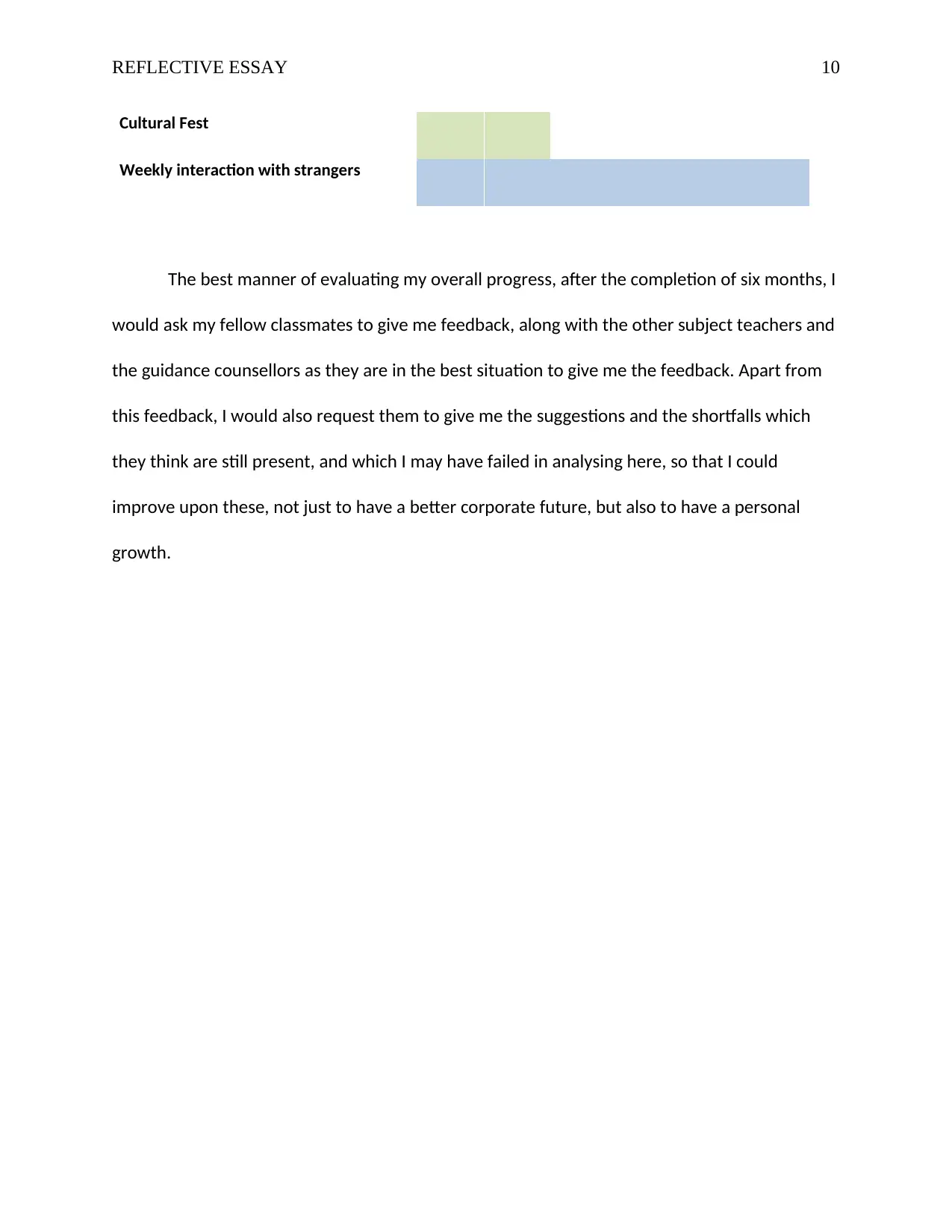
REFLECTIVE ESSAY 10
Cultural Fest
Weekly interaction with strangers
The best manner of evaluating my overall progress, after the completion of six months, I
would ask my fellow classmates to give me feedback, along with the other subject teachers and
the guidance counsellors as they are in the best situation to give me the feedback. Apart from
this feedback, I would also request them to give me the suggestions and the shortfalls which
they think are still present, and which I may have failed in analysing here, so that I could
improve upon these, not just to have a better corporate future, but also to have a personal
growth.
Cultural Fest
Weekly interaction with strangers
The best manner of evaluating my overall progress, after the completion of six months, I
would ask my fellow classmates to give me feedback, along with the other subject teachers and
the guidance counsellors as they are in the best situation to give me the feedback. Apart from
this feedback, I would also request them to give me the suggestions and the shortfalls which
they think are still present, and which I may have failed in analysing here, so that I could
improve upon these, not just to have a better corporate future, but also to have a personal
growth.
Paraphrase This Document
Need a fresh take? Get an instant paraphrase of this document with our AI Paraphraser
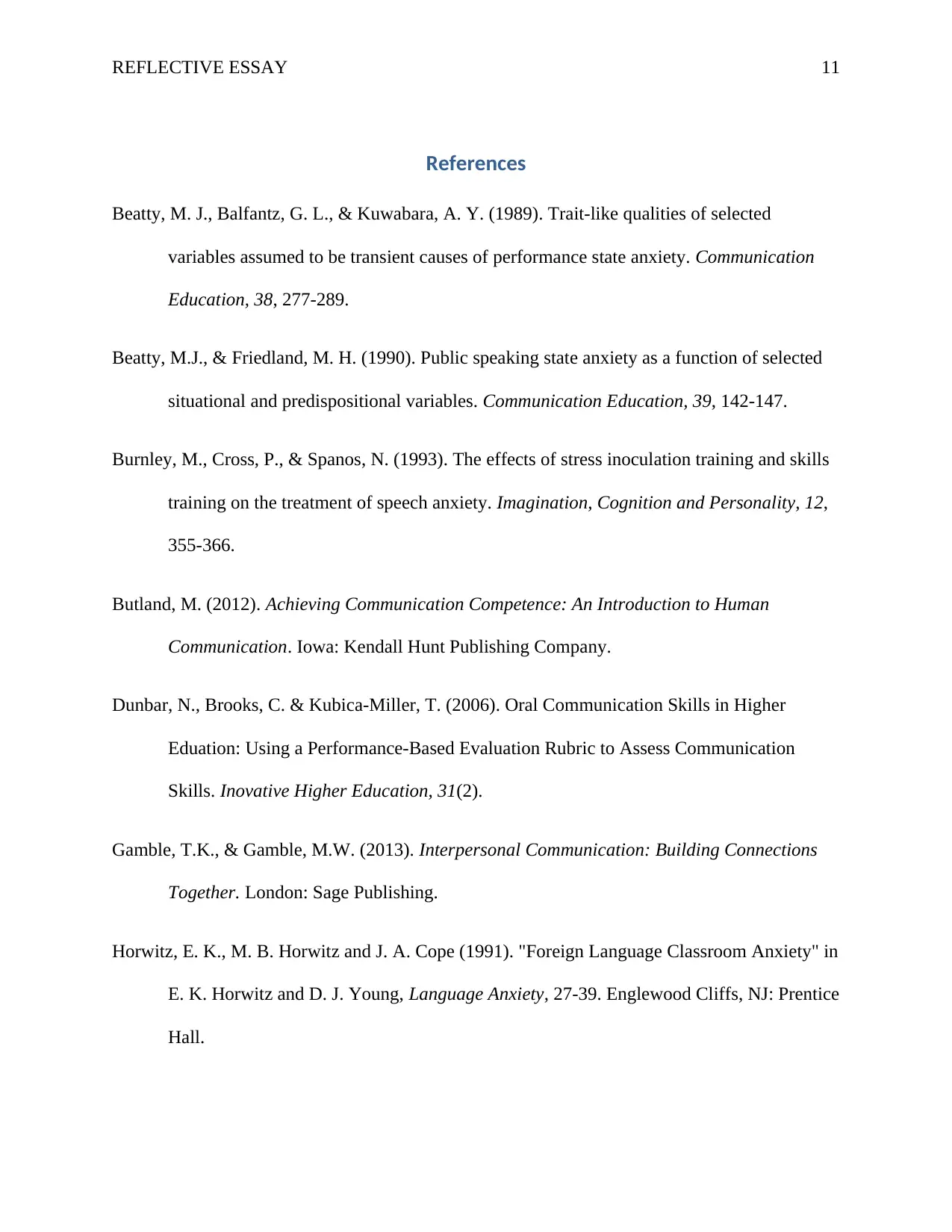
REFLECTIVE ESSAY 11
References
Beatty, M. J., Balfantz, G. L., & Kuwabara, A. Y. (1989). Trait-like qualities of selected
variables assumed to be transient causes of performance state anxiety. Communication
Education, 38, 277-289.
Beatty, M.J., & Friedland, M. H. (1990). Public speaking state anxiety as a function of selected
situational and predispositional variables. Communication Education, 39, 142-147.
Burnley, M., Cross, P., & Spanos, N. (1993). The effects of stress inoculation training and skills
training on the treatment of speech anxiety. Imagination, Cognition and Personality, 12,
355-366.
Butland, M. (2012). Achieving Communication Competence: An Introduction to Human
Communication. Iowa: Kendall Hunt Publishing Company.
Dunbar, N., Brooks, C. & Kubica-Miller, T. (2006). Oral Communication Skills in Higher
Eduation: Using a Performance-Based Evaluation Rubric to Assess Communication
Skills. Inovative Higher Education, 31(2).
Gamble, T.K., & Gamble, M.W. (2013). Interpersonal Communication: Building Connections
Together. London: Sage Publishing.
Horwitz, E. K., M. B. Horwitz and J. A. Cope (1991). "Foreign Language Classroom Anxiety" in
E. K. Horwitz and D. J. Young, Language Anxiety, 27-39. Englewood Cliffs, NJ: Prentice
Hall.
References
Beatty, M. J., Balfantz, G. L., & Kuwabara, A. Y. (1989). Trait-like qualities of selected
variables assumed to be transient causes of performance state anxiety. Communication
Education, 38, 277-289.
Beatty, M.J., & Friedland, M. H. (1990). Public speaking state anxiety as a function of selected
situational and predispositional variables. Communication Education, 39, 142-147.
Burnley, M., Cross, P., & Spanos, N. (1993). The effects of stress inoculation training and skills
training on the treatment of speech anxiety. Imagination, Cognition and Personality, 12,
355-366.
Butland, M. (2012). Achieving Communication Competence: An Introduction to Human
Communication. Iowa: Kendall Hunt Publishing Company.
Dunbar, N., Brooks, C. & Kubica-Miller, T. (2006). Oral Communication Skills in Higher
Eduation: Using a Performance-Based Evaluation Rubric to Assess Communication
Skills. Inovative Higher Education, 31(2).
Gamble, T.K., & Gamble, M.W. (2013). Interpersonal Communication: Building Connections
Together. London: Sage Publishing.
Horwitz, E. K., M. B. Horwitz and J. A. Cope (1991). "Foreign Language Classroom Anxiety" in
E. K. Horwitz and D. J. Young, Language Anxiety, 27-39. Englewood Cliffs, NJ: Prentice
Hall.
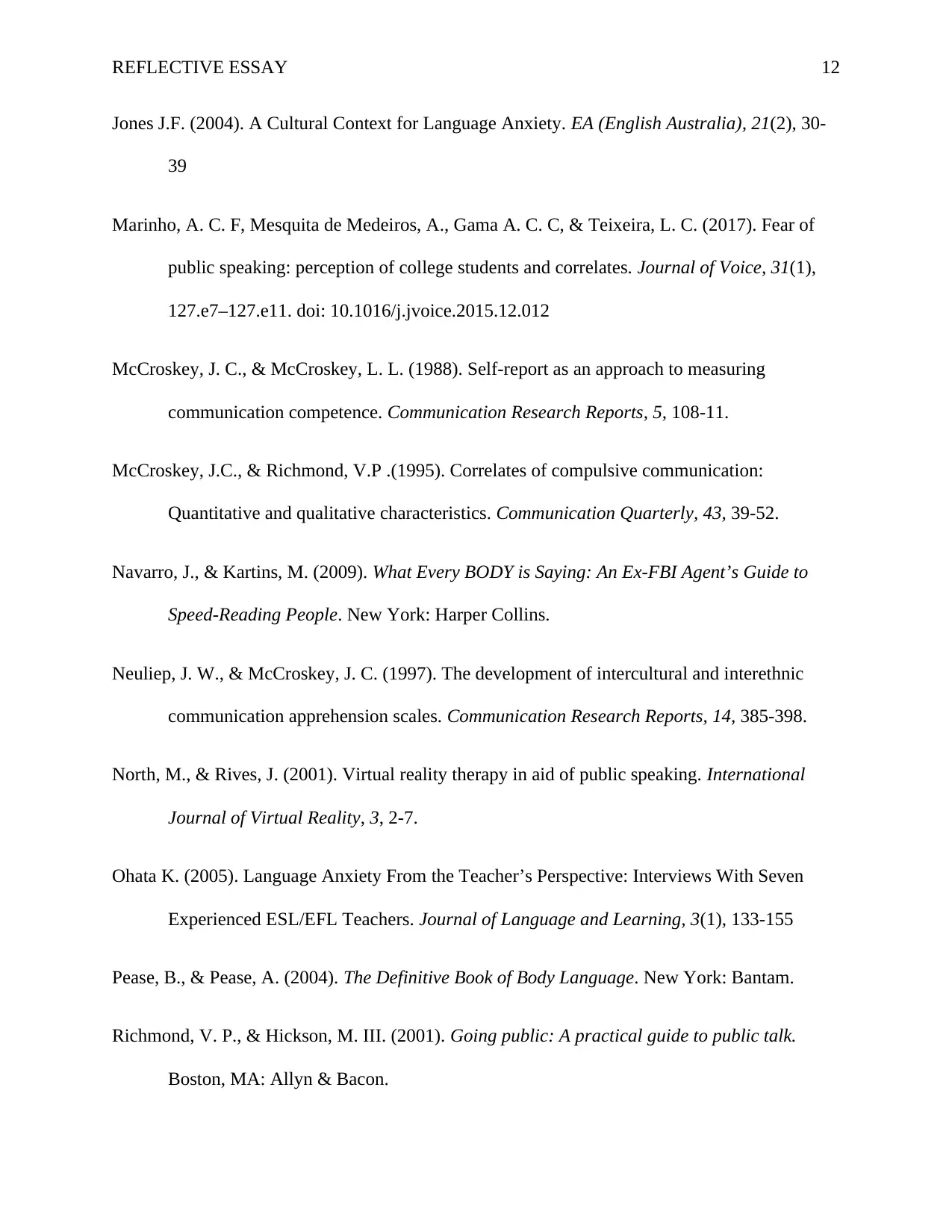
REFLECTIVE ESSAY 12
Jones J.F. (2004). A Cultural Context for Language Anxiety. EA (English Australia), 21(2), 30-
39
Marinho, A. C. F, Mesquita de Medeiros, A., Gama A. C. C, & Teixeira, L. C. (2017). Fear of
public speaking: perception of college students and correlates. Journal of Voice, 31(1),
127.e7–127.e11. doi: 10.1016/j.jvoice.2015.12.012
McCroskey, J. C., & McCroskey, L. L. (1988). Self-report as an approach to measuring
communication competence. Communication Research Reports, 5, 108-11.
McCroskey, J.C., & Richmond, V.P .(1995). Correlates of compulsive communication:
Quantitative and qualitative characteristics. Communication Quarterly, 43, 39-52.
Navarro, J., & Kartins, M. (2009). What Every BODY is Saying: An Ex-FBI Agent’s Guide to
Speed-Reading People. New York: Harper Collins.
Neuliep, J. W., & McCroskey, J. C. (1997). The development of intercultural and interethnic
communication apprehension scales. Communication Research Reports, 14, 385-398.
North, M., & Rives, J. (2001). Virtual reality therapy in aid of public speaking. International
Journal of Virtual Reality, 3, 2-7.
Ohata K. (2005). Language Anxiety From the Teacher’s Perspective: Interviews With Seven
Experienced ESL/EFL Teachers. Journal of Language and Learning, 3(1), 133-155
Pease, B., & Pease, A. (2004). The Definitive Book of Body Language. New York: Bantam.
Richmond, V. P., & Hickson, M. III. (2001). Going public: A practical guide to public talk.
Boston, MA: Allyn & Bacon.
Jones J.F. (2004). A Cultural Context for Language Anxiety. EA (English Australia), 21(2), 30-
39
Marinho, A. C. F, Mesquita de Medeiros, A., Gama A. C. C, & Teixeira, L. C. (2017). Fear of
public speaking: perception of college students and correlates. Journal of Voice, 31(1),
127.e7–127.e11. doi: 10.1016/j.jvoice.2015.12.012
McCroskey, J. C., & McCroskey, L. L. (1988). Self-report as an approach to measuring
communication competence. Communication Research Reports, 5, 108-11.
McCroskey, J.C., & Richmond, V.P .(1995). Correlates of compulsive communication:
Quantitative and qualitative characteristics. Communication Quarterly, 43, 39-52.
Navarro, J., & Kartins, M. (2009). What Every BODY is Saying: An Ex-FBI Agent’s Guide to
Speed-Reading People. New York: Harper Collins.
Neuliep, J. W., & McCroskey, J. C. (1997). The development of intercultural and interethnic
communication apprehension scales. Communication Research Reports, 14, 385-398.
North, M., & Rives, J. (2001). Virtual reality therapy in aid of public speaking. International
Journal of Virtual Reality, 3, 2-7.
Ohata K. (2005). Language Anxiety From the Teacher’s Perspective: Interviews With Seven
Experienced ESL/EFL Teachers. Journal of Language and Learning, 3(1), 133-155
Pease, B., & Pease, A. (2004). The Definitive Book of Body Language. New York: Bantam.
Richmond, V. P., & Hickson, M. III. (2001). Going public: A practical guide to public talk.
Boston, MA: Allyn & Bacon.
⊘ This is a preview!⊘
Do you want full access?
Subscribe today to unlock all pages.

Trusted by 1+ million students worldwide
1 out of 13
Related Documents
Your All-in-One AI-Powered Toolkit for Academic Success.
+13062052269
info@desklib.com
Available 24*7 on WhatsApp / Email
![[object Object]](/_next/static/media/star-bottom.7253800d.svg)
Unlock your academic potential
Copyright © 2020–2025 A2Z Services. All Rights Reserved. Developed and managed by ZUCOL.



